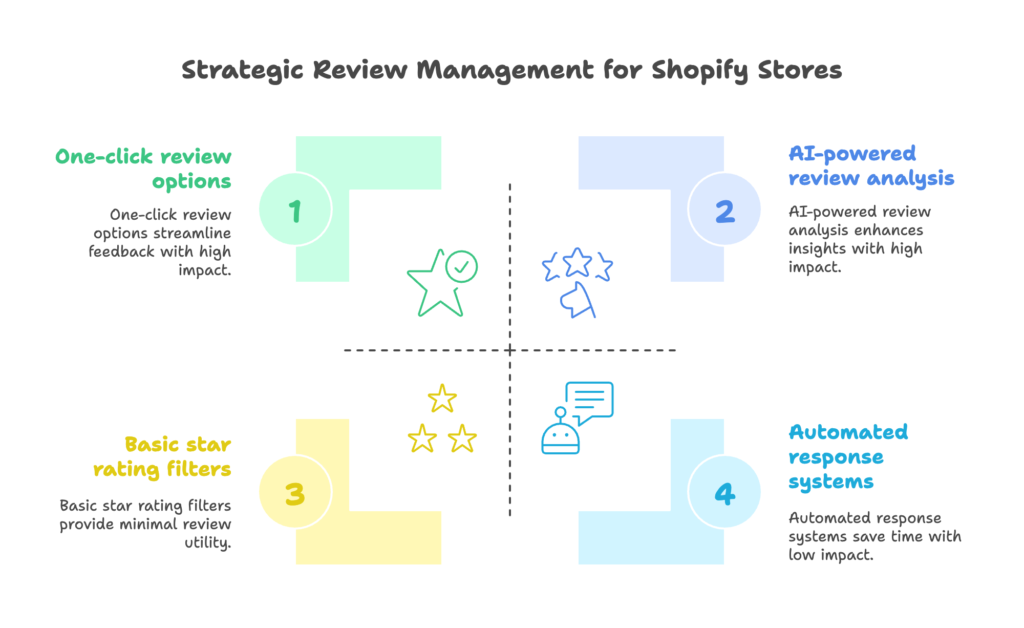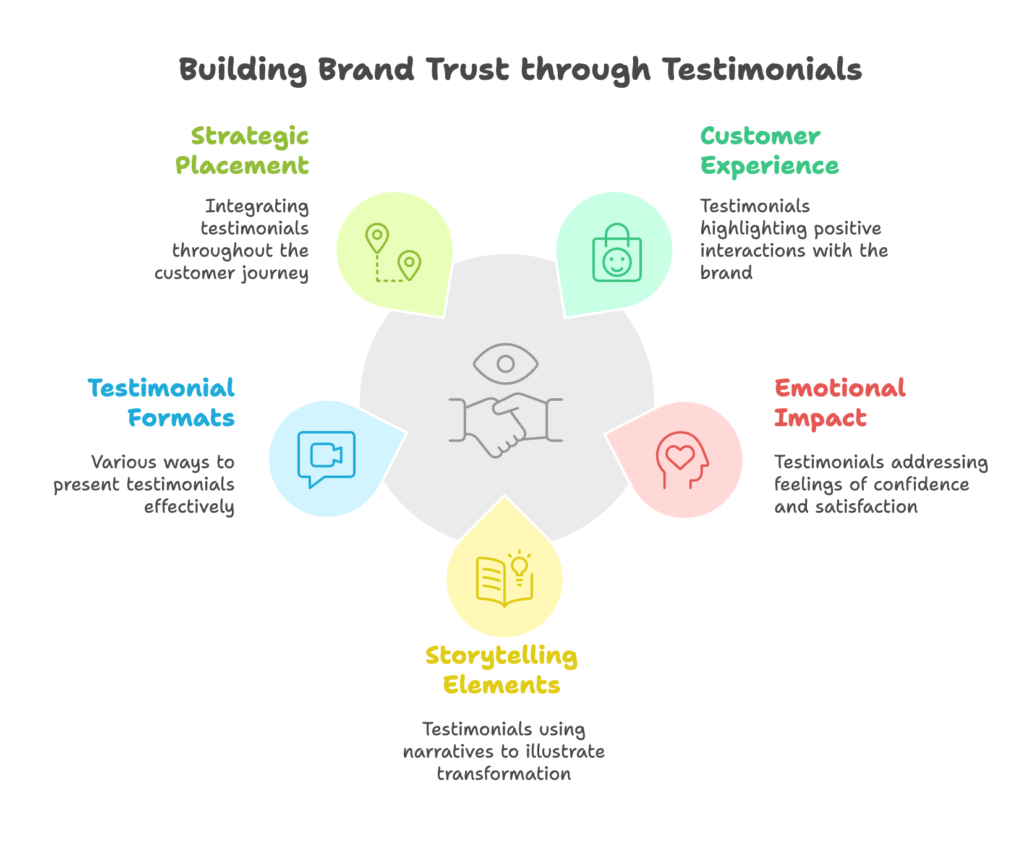Ever noticed how you’re more likely to try a restaurant when it’s packed with happy diners? Or how you instinctively reach for products with five-star ratings when shopping online? That’s social proof in action – and it could be the missing ingredient in your Shopify store’s conversion recipe.
Social proof isn’t just marketing jargon. It’s a fundamental psychological principle that influences nearly every purchase decision we make. When shoppers see evidence that others have purchased, used, and loved your products, a powerful trust signal fires in their brains. Suddenly, the risk of buying from you drops dramatically.
But here’s the kicker: up to 92% of consumers read online reviews before making a purchase, and displaying reviews can increase conversion rates by an impressive 270%. Those numbers aren’t just impressive – they’re game-changing for Shopify store owners fighting to stand out in a crowded marketplace.
What social proof is and why it matters
At its core, social proof is evidence that other people have purchased and validated your products. It taps into our inherent tendency to look to others for guidance when making decisions. We’ve evolved this way for a good reason – learning from others’ experiences helps us avoid mistakes and find quality more efficiently.
The psychological principle behind social proof is both simple and powerful. When faced with uncertainty (like whether to trust an online store), we naturally look for cues from others who’ve gone before us. It’s why testimonials from people who resemble your target customers can be so persuasive – we trust people who are similar to us.
For Shopify stores, effective social proof translates directly to your bottom line. Studies consistently show that product pages with robust social proof elements convert at rates 20-30% higher than those without. In fact, 72% of consumers won’t take any buying actions until they’ve read reviews.
Specific benefits for Shopify store owners

For you as a Shopify store owner, implementing strong social proof elements delivers three immediate benefits:
- Increased trust and credibility: In a digital world where customers can’t physically touch your products, social proof bridges the trust gap. It transforms your store from an unknown entity to a validated, customer-approved business.
- Higher conversion rates: When hesitation is the enemy of sales, social proof provides the reassurance shoppers need to click “Add to Cart.” Product pages with reviews convert at rates 3.5 times higher than those without.
- Reduced cart abandonment: Nearly 61% of shoppers abandon carts because of trust concerns. Strategic social proof elements throughout the purchase journey can address these concerns before they lead to abandonment.
Types of Social Proof for Product Pages
Not all social proof is created equal. The most effective Shopify stores use a strategic mix of these five key types:
- Customer reviews and ratings: The bread and butter of product page social proof, where customers share experiences and rate products.
- User-generated content: Customer photos, videos, and social media posts showing your products in real-world use.
- Testimonials: In-depth customer stories highlighting transformative experiences with your products.
- Trust badges and certifications: Visual symbols showing security, quality guarantees, and industry credentials.
- Social media proof: Follower counts, shared content, and evidence of community engagement with your brand.
How social proof impacts different customer segments
The beauty of social proof is how it works across different customer types – but understanding how various segments respond helps you maximize its impact.
First-time visitors respond most strongly to trust signals that reduce perceived risk. For these shoppers, security badges, review counts, and recognizable verification symbols create an immediate trust foundation. Returning customers, on the other hand, are more influenced by quality reinforcement – detailed reviews that affirm their previous good experience.
Shoppers making high-consideration purchases (expensive or complex products) need more substantial social proof. They’re likely to read multiple in-depth reviews, study user photos, and seek specific testimonials addressing their concerns. Impulse purchase categories benefit most from quick-glance social proof – star ratings, review counts, and simple trust indicators that don’t slow down the buying momentum.
And don’t forget to consider your audience’s primary motivations. Price-sensitive shoppers gravitate toward reviews mentioning value, durability, and cost-effectiveness. Quality-focused customers pay more attention to reviews highlighting craftsmanship, premium features, and exceptional experiences.
Strategic Implementation of Customer Reviews
Reviews are the cornerstone of effective social proof, but there’s a world of difference between having a few scattered reviews and implementing a strategic review system. Let’s tackle this from collection to display.
Optimizing Review Collection
The most successful Shopify stores don’t leave review collection to chance. They strategically time review requests to maximize both quantity and quality. The sweet spot typically falls 7-14 days after delivery – enough time for customers to experience the product, but not so long that their enthusiasm has faded.

Your post-purchase email sequence should include a precisely timed review request. Start with a delivery confirmation, follow with a usage tip email, then make your review request when the customer has had time to experience your product’s benefits. For non-responders, a gentle reminder 3-5 days later can increase review submission rates by up to 40%.
While incentivizing reviews can boost your numbers, tread carefully. Small tokens of appreciation (loyalty points, entry into a monthly drawing, or a modest discount on future purchases) work well, but avoid anything that feels like “paying” for reviews. Not only does this violate marketplace policies, but customers can smell inauthentic reviews a mile away.
Making the review process frictionless
Customer time is precious. Every step you add to the review process will decrease completion rates by 10-15%. The most effective review systems implement:
- One-click review options: Allow customers to submit a star rating with a single click, then offer (but don’t require) additional feedback fields.
- Mobile-friendly forms: With over 70% of Shopify store traffic coming from mobile devices, your review form must be thumb-friendly with large tap targets and minimal typing requirements.
- Photo and video capabilities: Products in categories like fashion, home decor, and beauty see 40% higher conversion rates when reviews include customer photos or videos. Make submitting visual content as simple as possible.
Encouraging detailed, helpful reviews
Quality trumps quantity when it comes to reviews. A single detailed, authentic review can outperform dozens of generic “Great product!” comments.
Instead of asking “How was your experience?”, prompt specific insights with questions like “What problem did this product solve for you?” or “What feature surprised you most?” These targeted questions generate more helpful content for future shoppers.
Consider providing simple review templates that guide customers without being prescriptive: “I purchased this for… I especially liked… One thing to be aware of is…” This approach yields more balanced, thoughtful reviews that future customers find genuinely helpful.
Strategic Review Display on Product Pages
Where and how you display reviews significantly impacts their effectiveness. The conversion-optimized approach includes three key components:
Placement considerations for maximum impact
Reviews shouldn’t be an afterthought buried at the bottom of your product pages. The review summary (average rating and count) belongs above the fold, preferably near the product title or price, where it immediately builds credibility.
Detailed reviews work best below your product description, where they continue the natural flow of product information. For products where visual validation matters (clothing, decor, cosmetics), consider featuring a gallery of customer photos within your product image carousel.
Some top-performing Shopify stores also implement review highlights – extracting key phrases from positive reviews and featuring them in callout bubbles near relevant product features.
Filtering and sorting options
Different customers seek different information from reviews. Empowering them to filter and sort reviews dramatically increases their utility:
- Star rating filters: Allow shoppers to view reviews of specific ratings (particularly helpful for customers trying to understand potential downsides).
- Verified purchaser identification: Clearly mark reviews from confirmed buyers, which 76% of shoppers consider more trustworthy.
- Relevance vs. recency sorting: Offer sorting by date (showing your product receives ongoing positive feedback) and by helpfulness (surfacing the most valuable reviews).
For products with numerous attributes (size, color, fit, etc.), consider attribute-specific filtering. A shopper considering a “medium” can quickly find reviews from others who purchased that size.
Highlighting reviews with images and videos
Visual reviews are conversion gold. Products with customer photos see an average 91% higher conversion rate compared to those without.
Create a dedicated visual review gallery where shoppers can browse customer images and videos. This not only provides social proof but helps answer questions about how products look in real life – a major concern for online shoppers.
Consider integrating customer photos alongside your professional product images, clearly marked as “Customer Photo.” This creates an authentic counterpoint to your styled product photography and builds trust through transparency.
Leveraging Shopify Apps for Review Management
The right review app can transform your social proof strategy from manageable to exceptional. Let’s compare some top contenders:
Top review apps comparison
Judge.me offers an impressive free tier with core functionality and seamless theme integration. Its standout features include in-email review submission (allowing customers to submit reviews directly from request emails) and an AI-assisted review analysis that identifies key themes and sentiment.
Loox specializes in photo reviews with an elegant display format. It excels at incentivizing photo submission and creates beautiful visual galleries. The photo-centric approach makes it ideal for visually-driven product categories.
Ali Reviews offers powerful import capabilities for stores transitioning from other platforms or those dropshipping from AliExpress. Its standout feature is the review reminders system, which has shown to increase review submission rates by up to 72%.
Advanced review features to consider
As your store grows, these sophisticated features can take your review strategy to the next level:
- AI-powered review analysis: Automatically identify common themes, sentiment patterns, and product insights from review content.
- Review moderation workflows: Create rules-based systems that flag potentially problematic reviews for moderation while automatically publishing those that meet your criteria.
- Automated response systems: Set up templates to respond to reviews based on rating or keywords, ensuring customers feel heard while saving you time.
Implementation best practices
When adding a review app to your Shopify store, check theme compatibility first. Most major review apps work with popular themes, but custom themes may require adjustments. Request support from the app provider before committing if you use a custom theme.
Performance matters – review widgets with excessive loading requirements can slow your product pages. Opt for apps that lazy-load review content and compress customer images to maintain site speed.
Finally, ensure your review display remains fully functional on mobile devices. Test the complete review experience – from reading to submitting – on multiple devices before finalizing your implementation.
Testimonials as Persuasive Social Proof
While reviews offer product-specific feedback, testimonials tell a broader story about the customer experience with your brand. This distinction makes testimonials extraordinarily powerful for building brand-level trust.

Differentiating Testimonials from Reviews
Reviews answer “How does this product perform?” Testimonials answer “How did this purchase change something for me?” This fundamental difference shapes how you should collect and display them.
Strategic purpose of testimonials
Testimonials work at the brand level, building confidence in your store’s overall quality, service, and reliability. Where reviews focus on product specifications and performance, testimonials highlight the emotional and practical impact of doing business with you.
The most effective testimonials balance functional benefits (“The shipping was incredibly fast”) with emotional outcomes (“I finally found jeans that make me feel confident again”). This combination addresses both the rational and emotional sides of purchasing decisions.
Great testimonials also incorporate storytelling elements – a before state, the purchase decision, and the positive after state. This narrative structure helps potential customers envision a similar transformation in their own lives.
Testimonial formats for Shopify stores
Text testimonials remain the workhorse format – easy to collect, display, and scan. They work well when featuring a customer quote, name, and small photo to increase authenticity.
Video testimonials, though harder to obtain, deliver substantially higher impact. A 30-second authentic customer video can increase product page conversion rates by 80% or more. The unscripted, authentic nature of video builds trust in a way text simply cannot match.
For complex or high-value products, consider detailed case studies that follow a customer’s complete journey with your product. These work particularly well for B2B Shopify stores or those selling transformative consumer products.
Collecting Compelling Testimonials
Not all customers make equally effective testimonial sources. Focus your collection efforts on these high-potential groups:
Identifying ideal testimonial candidates
Loyal customers who have made multiple purchases understand your brand value and can speak authentically about why they keep coming back. They’re often willing to provide testimonials with minimal incentive since they already value your relationship.
Customers who have had transformative experiences with your products make particularly compelling testimonial sources. Look for buyers who have mentioned significant positive outcomes in reviews, customer service interactions, or social media posts.
Aim for diverse representation in your testimonials. Shoppers trust testimonials more when they can identify with the person giving them. Variety in age, background, use cases, and demographics helps different customer segments find relevant social proof.
Crafting effective testimonial requests
Personalized outreach significantly outperforms generic requests. Mention a specific purchase or interaction: “I noticed you’ve ordered our premium yoga mat three times now – would you be willing to share why you keep coming back to us?”
Guide contributors with questions that elicit powerful responses: “What were you struggling with before finding our product?” “What specific benefit has surprised you the most?” “How has using our product affected your daily life?” These prompts generate more compelling content than open-ended requests.
Always secure proper permissions, particularly for photo or video testimonials. A simple release form should clarify how you’ll use their content, how long you’ll display it, and whether you’ll use their full name. Some customers prefer first name only or initials, which still conveys authenticity while protecting privacy.
Strategic Testimonial Placement
Testimonials lose impact when confined to a dedicated “testimonials” page that few visitors see. Strategic integration throughout the shopping journey maximizes their persuasive power.
Product page integration options
Testimonial sliders or carousels work well in the middle or lower section of product pages, where they provide a persuasive boost just as shoppers may be considering alternatives. Limit these to 3-5 strong testimonials to avoid overwhelming visitors.
Contextual placement – positioning testimonials directly adjacent to related product features or benefits – increases their impact. For example, place durability-focused testimonials next to your product quality descriptions.
For particularly powerful testimonials, consider using subtle pop-ups triggered after a visitor has shown engagement (such as scrolling 50% down the page or spending more than 30 seconds on it).
Cross-page testimonial strategies
While dedicated testimonial pages may not drive conversions directly, they serve as excellent link destinations from product pages. “See what 200+ customers say about their experience” provides both social proof and a path to more in-depth validation for those who need it.
Category-specific testimonial displays help address the particular concerns of different product types. Shoppers considering skincare have different concerns than those buying electronics, and your testimonials should reflect these distinctions.
The checkout page represents a critical moment of decision where doubts often resurface. Strategic testimonials that address common concerns like shipping, returns, or product quality can reduce checkout abandonment by up to 15%.
Trust Badges and Verification Elements
Trust badges provide instant visual reassurance about specific concerns shoppers have when considering a purchase. They’re the quickest form of social proof, communicating trust in a single glance.
Types of Trust Badges for Shopify Stores
Different badges address specific trust barriers. The most effective Shopify stores use a strategic combination of:
Payment security badges
SSL certificates and secure checkout indicators address the fundamental concern: “Is it safe to enter my credit card here?” The padlock icon and “Secure Checkout” text remain powerfully effective trust signals despite their simplicity.
Payment processor logos like PayPal, Shop Pay, Apple Pay, and major credit cards serve dual purposes – they assure customers their payment information is protected by trusted companies while also indicating convenient payment options.
PCI compliance indicators may seem technical, but they signal to security-conscious shoppers that your store adheres to the Payment Card Industry’s rigorous data security standards. This becomes increasingly important for stores targeting older demographics or selling high-value items.
Third-party verification badges
Industry certifications relevant to your product category build specialized credibility. Organic certifications for food products, OEKO-TEX for textiles, or cruelty-free badges for cosmetics speak directly to conscious consumers’ concerns.
Better Business Bureau, TrustPilot, or Google Customer Reviews badges leverage the trust these established platforms have already built. Their familiar logos transfer credibility to your store through association.
Security verification services like Norton Secured or McAfee Secure address concerns about overall website safety and data protection. While tech-savvy shoppers may not need these reassurances, they significantly impact trust for less confident online buyers.
Guarantee and policy badges
Money-back guarantee symbols directly address the fear of being stuck with an unsatisfactory purchase. Specificity helps – “30-Day No-Questions-Asked Returns” conveys more confidence than a generic “Satisfaction Guaranteed” badge.
Free shipping indicators have become almost mandatory in competitive niches. These badges work best when they specify any conditions (“Free Shipping on Orders $50+”) to avoid checkout surprises.
Return policy highlights summarizing your customer-friendly policies (“Free Returns,” “Easy 60-Day Returns”) reduce purchase anxiety, particularly for products where fit, color, or functionality might be difficult to judge online.
Strategic Badge Placement
Even the most impressive badges lose impact when poorly placed. Strategic placement ensures shoppers see relevant trust signals exactly when concerns might arise.
Product page placement optimization
Near add-to-cart buttons is prime real estate for trust badges. This position addresses last-moment hesitation with reassurance about security, guarantees, or shipping – precisely when shoppers are weighing final purchase decisions.
Within product description sections, place badges relevant to product quality or authenticity claims. If you mention “certified organic ingredients,” the corresponding certification badge should appear nearby to validate this claim.
Price and shipping information areas benefit from badges addressing financial concerns – payment security, price guarantees, and free shipping indicators all reduce friction at the point where customers are evaluating the financial aspects of their purchase.
Mobile-specific considerations
On mobile devices, screen real estate is precious. Prioritize 2-3 of your most impactful badges rather than shrinking a larger collection to illegibility. Security and guarantee badges typically deliver the highest impact per pixel.
Consider expandable trust information sections that allow interested mobile shoppers to tap for additional details without cluttering the primary shopping experience. A simple “Our Guarantees +” dropdown can house multiple trust elements in an accessible but unobtrusive format.
Ensure all badges are tap-friendly with sufficient spacing for accurate finger navigation. Nothing undermines trust faster than frustration with your mobile interface.
Implementing Trust Badges in Shopify
Shopify offers several built-in options for trust badge implementation, along with more advanced app-based solutions.
Native Shopify options
Many Shopify themes include built-in locations for trust badges in the theme settings. Look for sections labeled “Trust badges,” “Payment icons,” or “Footer logos” in your theme customizer.
Shopify Payments automatically displays relevant security features like Shop Pay and various payment method icons. If you’re using Shopify Payments, enable these built-in elements before adding third-party alternatives.
Leverage Shopify’s built-in security features by enabling their visibility in your checkout settings. The platform’s secure checkout messaging is particularly effective because shoppers recognize and trust the Shopify brand.
Third-party apps for trust enhancement
Several specialized apps offer expanded trust badge capabilities. Trust Badge by Hextom provides a comprehensive library of professional badge designs with flexible placement options. Trust Hero focuses on real-time social proof notifications alongside traditional badges.
When evaluating badge apps, consider both the badge library quality and the implementation flexibility. The best apps allow precise placement control without requiring theme code modifications.
Monitor performance impacts carefully – some badge collections load external resources that can slow your store. Choose apps that use compressed images and minimal external scripts to maintain site speed.
User-Generated Content as Social Proof
User-generated content (UGC) represents the pinnacle of authentic social proof. Nothing convinces potential customers like seeing real people – not models or marketers – using and loving your products in their everyday lives.
Types of UGC for Product Pages
The most effective UGC strategies leverage multiple content formats to create a comprehensive picture of your products in action.
Customer photos and videos
Unboxing content captures the excitement of receiving your product. These images and videos build anticipation for the shopping experience while demonstrating packaging quality, presentation, and included materials.
Product-in-use demonstrations show your items in their natural habitat, helping shoppers envision ownership. For apparel, this might be styling examples; for kitchen tools, cooking demonstrations; for tech products, feature showcases.
Before/after comparisons provide powerful validation for transformative products. Skincare, fitness equipment, home organization tools, and similar categories benefit enormously from visual evidence of results.
Social media mentions and tags
Instagram feed integration on product pages connects your curated brand image with authentic customer content. Solutions like Foursixty and Pixlee make it simple to display hashtagged content from satisfied customers directly on relevant product pages.
TikTok content has emerged as particularly persuasive for younger demographics. The unfiltered, authentic nature of TikTok videos builds trust through their perceived spontaneity and honesty.
Twitter testimonials – brief, punchy customer endorsements – work especially well for products with enthusiastic fan bases. Their concise format makes them perfect for featuring near add-to-cart buttons or in checkout flows.
Q&A and community discussions
Customer questions and answers provide peer-to-peer validation that often addresses concerns more authentically than merchant-created content. A robust Q&A section shows transparency while preemptively addressing common concerns.
Community tips and usage advice help shoppers see the product as part of a lifestyle or solution, not just an isolated purchase. This content often highlights versatility and creative applications you might not have considered in your official descriptions.
Problem-solving discussions demonstrate your product’s effectiveness in addressing specific challenges. When potential customers see others successfully using your product to solve similar problems, conversion resistance drops significantly.
UGC Collection Strategies
The most successful Shopify stores proactively generate a steady stream of quality UGC rather than waiting for it to appear organically.
Hashtag campaigns and contests
Creating branded hashtags gives customers a simple way to share content while making it easily discoverable for your team. Effective branded hashtags are memorable, unique to your brand, and clearly communicable in packaging and post-purchase emails.
Incentivizing UGC submission through contests dramatically increases participation rates. Monthly photo contests with modest prizes (store credit, featured placement, or exclusive access) can generate hundreds of authentic content pieces while building community.
Always address rights management upfront. Your contest rules or hashtag campaign should clearly state that tagged content may be featured on your site, and provide an opt-out method for customers who change their minds about participation.
Post-purchase engagement
Email sequences requesting UGC should be timed when customers are most excited about their purchase. For many products, this falls between 7-14 days after delivery – after they’ve experienced benefits but while enthusiasm remains high.
Loyalty program integration can make UGC submission an explicit reward activity. Offering points or status for quality photo submissions creates ongoing motivation while rewarding your most engaged customers.
Exclusive community access provides a powerful non-monetary incentive for content creation. A VIP customer group that receives early access to new products, special discounts, or direct communication with your team can become a consistent UGC engine.
Displaying UGC on Shopify Product Pages
Collecting great UGC is only half the battle – displaying it effectively turns that content into conversion power.
Technical implementation options
Several Shopify apps specialize in UGC display. Yotpo excels at visual marketing with robust rights management. Stamped.io offers a comprehensive solution integrating reviews, photos, and videos. Junip provides elegant, highly customizable UGC galleries.
For stores with development resources, custom section development allows perfect alignment with your brand aesthetic and functionality needs. This approach provides maximum flexibility but requires technical expertise to implement and maintain.
Regardless of your implementation method, prioritize performance optimization. Image compression, lazy loading (where content loads only as the user scrolls to it), and efficient caching can maintain speed while incorporating rich UGC elements.
Curation and moderation best practices
Content filtering workflows ensure only the most persuasive UGC reaches your product pages. Establish clear criteria for what makes compelling content – clear images, authentic usage, diverse representation – and apply these standards consistently.
Quality standards should balance authenticity with effectiveness. While polished, professional-looking customer content might seem ideal, sometimes slightly imperfect but genuine content builds more trust. The key is finding content that’s authentic without being unprofessional.
Have a plan for negative content management. Not all user content will be positive, and your response to critical UGC affects how shoppers perceive your brand. Consider displaying some balanced criticism (with your constructive response) to build trust through transparency.
Measuring UGC impact
Track engagement metrics to understand which UGC resonates most with your audience. Click rates, time spent viewing UGC galleries, and interaction patterns provide insights for continuous refinement of your content strategy.
Conversion attribution helps quantify UGC’s financial impact. Implement tracking that identifies whether visitors who engaged with UGC converted at higher rates than those who didn’t. This data justifies continued investment in UGC programs.
A/B testing methodologies allow you to refine your UGC strategy with precision. Test different UGC placements, quantities, formats, and highlight methods to identify the specific approach that drives the highest conversion lift for your unique audience.
Advanced Social Proof Strategies
Once you’ve implemented the fundamental social proof elements, these advanced strategies can take your conversion rates to the next level.
Dynamic and Personalized Social Proof
Static social proof is powerful, but dynamic elements create urgency and excitement through real-time validation.
Real-time activity notifications
Recent purchase popups showing messages like “James in Toronto just purchased this item” create a sense of active demand. These notifications are particularly effective for products where popularity or scarcity affects purchase decisions.
“Currently viewing” indicators showing how many other shoppers are examining the same product creates subtle urgency while validating interest. The key is accuracy – use actual data rather than artificially inflated numbers that can damage trust.
Stock scarcity alerts (“Only 3 left!”) combine social proof with urgency when they reflect genuine inventory limitations. Shoppers interpret limited availability as evidence of popularity, making these alerts doubly effective when truthfully implemented.
Personalized social proof elements
Geolocation-based testimonials that prioritize content from customers in the shopper’s region can increase relevance and relatability. Someone in Seattle may find a Seattle customer’s experience more persuasive than one from Miami.
Highlighting reviews and testimonials from customers with similar purchasing patterns creates powerful personal relevance. “Customers who bought items you’ve purchased also loved this product” combines personalization with social validation.
Behavioral targeting techniques allow you to display different social proof elements based on traffic source, visit history, or cart contents. A visitor from Pinterest might see visual-heavy social proof, while someone from a professional forum might see more detailed technical testimonials.
Combining Multiple Social Proof Elements
The most successful Shopify stores don’t rely on isolated social proof elements. They create an integrated ecosystem where different types of validation reinforce each other.
Creating a cohesive trust ecosystem
Consider visual hierarchy when combining multiple elements. Your most persuasive social proof (often star ratings or review counts) should receive visual prominence, while supporting elements create depth without competing for attention.
Select complementary proof elements that address different aspects of the purchase decision. Reviews might speak to product quality, while trust badges address security concerns, and testimonials cover the overall customer experience. Together, they create comprehensive reassurance.
Cross-referencing between proof types strengthens each element. When a customer review mentions excellent service, link to your service-focused testimonials. When someone questions durability in your Q&A section, highlight relevant reviews addressing long-term use.
Avoiding social proof overload
Too much social proof can create cognitive overload, actually reducing its effectiveness. Follow decluttering strategies like consolidating similar elements, establishing a clear visual hierarchy, and removing redundant trust signals.
Progressive disclosure techniques present basic social proof upfront while making detailed validation available one click away. A summary showing “4.8/5 stars (493 reviews)” with an expansion option provides immediate credibility while keeping the interface clean.
Regular testing for optimal density ensures you’re providing enough social proof without overwhelming visitors. A/B test different combinations and quantities to find the sweet spot where conversion rates peak before declining from information overload.
Addressing Negative Social Proof
Negative feedback is inevitable, but how you handle it can actually strengthen rather than damage trust.
Managing negative reviews effectively
Develop response protocols that transform criticism into an opportunity to demonstrate exceptional service. A prompt, non-defensive response acknowledging concerns and offering solutions shows potential customers that you stand behind your products.
View complaints as service recovery opportunities with significant ROI. Research shows that customers whose problems are effectively resolved often become more loyal than those who never experienced issues. A visible resolution process builds confidence in your post-purchase support.
Some of your most vocal critics can become powerful advocates when their concerns are addressed thoroughly. Reaching out personally to dissatisfied customers and exceeding expectations in making things right can transform negative reviews into updated positive ones.
Using negative reviews constructively
Negative feedback provides invaluable product improvement feedback. When multiple customers mention similar issues, they’re giving you a direct roadmap for product enhancement. Addressing these issues and then highlighting the improvements shows responsiveness and commitment to quality.
Transparency and authenticity in review displays builds more trust than a suspiciously perfect rating. Studies show that products with a 4.7-4.8 star average actually convert better than those with a perfect 5.0, as shoppers perceive these ratings as more authentic.
Use negative reviews to demonstrate honesty by responding constructively. Your thoughtful responses to criticism often impress potential customers more than the original negative review deters them. This transparent approach creates a foundation of trust that artificial perfection never could.
Measuring and Optimizing Social Proof Impact
Like any strategic marketing element, social proof requires ongoing measurement and refinement to maximize its impact on your bottom line.
Key Performance Indicators
Track these metrics to understand exactly how your social proof strategy affects customer behavior and store performance.
Conversion metrics
Product page conversion rate changes provide the most direct measure of social proof effectiveness. Compare conversion rates before and after implementing new social proof elements, or between pages with different approaches.
Add-to-cart rate improvements often appear before overall conversion increases. This metric helps isolate the impact of product page social proof from other factors affecting final checkout completion.
Checkout completion increases may indicate effective social proof elements in your cart and checkout flow. Trust badges and checkout testimonials can reduce last-minute abandonment by addressing final hesitations.
Engagement metrics
Time spent on product pages typically increases with effective social proof implementation. Shoppers engage more deeply with pages that contain authentic validation, particularly when review content is substantial and relevant.
Review engagement statistics reveal which types of social proof resonate most with your audience. Track metrics like review expansion clicks, filter usage, and time spent in review sections to understand how shoppers interact with this content.
Social proof element interaction rates show which specific elements draw the most attention. Heat mapping and click tracking can identify your most compelling trust signals and help optimize their placement and prominence.
Long-term impact metrics
Customer lifetime value correlations often reveal that shoppers acquired through robust social proof become more valuable over time. Their initial confidence typically translates to higher repeat purchase rates and average order values.
Repeat purchase behavior analysis can demonstrate how social proof affects customer retention. Shoppers who made their initial purchase based on strong social validation often show greater loyalty than those who bought based on price or convenience factors alone.
Brand advocacy measurements like referral rates, social sharing, and UGC contribution help quantify how social proof creates a virtuous cycle of customer-driven growth. Customers who purchased based on others’ validation are more likely to provide their own positive validation for future shoppers.
A/B Testing Methodologies
Systematic testing reveals which specific approaches drive the strongest results for your unique store and audience.
Testing review display variations
Experiment with quantity vs. quality emphasis to find your optimal balance. Some stores perform better highlighting a large number of reviews (“2,347 five-star reviews”), while others see better results featuring fewer, more detailed reviews.
Test different star rating visualization options – graphical stars, numerical ratings, percentage positives, or recommendation rates may resonate differently with your specific audience. Even minor variations in how ratings are presented can impact conversion rates by 5-15%.
Compare review sorting default options to determine whether chronological, helpfulness-based, or rating-based sorting drives higher engagement and conversion. The initial presentation of reviews significantly influences their persuasive impact.
Trust badge optimization tests
Badge design variations can produce surprisingly different results. Test simplified vs. detailed badge designs, color variations, and size options to identify the most effective visual presentation for your brand aesthetic.
Placement alternatives worth testing include near-product vs. near-price vs. near-button positions. Small shifts in badge location can dramatically impact their attention capture and persuasive power.
Evaluate different badge combinations to find complementary groupings that address multiple trust barriers without creating visual clutter. Sometimes three well-chosen badges outperform a larger collection of less-targeted trust elements.
Testimonial effectiveness testing
Compare format performance across text, video, and mixed-media testimonials. While video generally shows higher engagement rates, the additional loading time and attention requirements may affect overall page performance.
Test length and detail variations to find the sweet spot between comprehensive validation and information overload. Short, punchy testimonials may work better above the fold, while detailed success stories might drive higher conversion when placed further down the page.
Evaluate how demographic representation in testimonials affects conversion among different customer segments. Often, shoppers respond most strongly to testimonials from people who resemble them in age, lifestyle, or use case.
Continuous Improvement Framework
The most successful Shopify stores view social proof as an evolving strategy requiring ongoing refinement.
Regular social proof audits
Conduct freshness assessments quarterly to ensure your social proof remains current. Outdated reviews, testimonials referring to previous product versions, or expired certification badges can damage rather than build trust.
Evaluate relevance regularly as your product line and customer base evolve. Social proof that resonated with early adopters might not connect as strongly with mainstream customers as your brand grows.
Perform competitive benchmarking to understand how your social proof strategy compares to others in your niche. This process often reveals opportunities for differentiation or improvement that internal analysis might miss.
Seasonal and promotional adjustments
Develop holiday-specific social proof highlighting seasonal use cases, gift worthiness, or special occasion relevance. Testimonials mentioning “perfect Christmas gift” or “ideal for summer travel” become particularly effective during relevant periods.
For new product launches, curate early reviewer programs that generate initial social proof. Without this proactive approach, the “empty restaurant” effect can handicap new products until organic reviews accumulate.
During sale periods, highlight reviews mentioning value, durability, and long-term satisfaction to counteract discount-focused shopping behavior. These quality reinforcements help maintain margin by justifying regular pricing after promotions end.
Conclusion: Building a Social Proof Strategy
A comprehensive social proof strategy transforms how shoppers perceive and interact with your Shopify store. By systematically implementing the techniques we’ve explored, you’ll build a foundation of trust that drives sustainable growth.
Implementation Roadmap
Begin with these quick wins for immediate impact: implement a review collection system, add basic trust badges near your checkout button, and gather 3-5 strong testimonials from your best customers. These fundamental elements will start building trust while you develop more sophisticated components.
In the medium term, focus on developing user-generated content through post-purchase campaigns, integrating more advanced review features, and implementing strategic testimonial placement throughout your customer journey. This phase deepens engagement while expanding your social proof ecosystem.
Your long-term social proof ecosystem should include personalized elements, sophisticated A/B testing, and seamless integration across marketing channels. Mature social proof strategies connect on-site validation with social media, email marketing, and advertising to create consistent trust reinforcement at every customer touchpoint.
Future Trends in Social Proof
Watch for these emerging developments as social proof continues to evolve:
AI-enhanced social proof curation will increasingly personalize which reviews and testimonials each visitor sees based on their behavior, demographics, and purchase intent signals. This targeted approach dramatically increases relevance and persuasive impact.
Video-first review experiences are gaining momentum as smartphone capabilities and connection speeds improve. Younger demographics in particular respond strongly to authentic video content, suggesting this format will become increasingly dominant.
Augmented reality social proof integration represents the next frontier, allowing shoppers to visualize products in their environment alongside review data and user demonstrations. This immersive approach combines validation with visualization for maximum impact.
Final Recommendations
Start small and scale strategically. Begin with foundational elements that deliver the highest ROI – typically star ratings, review counts, and basic trust badges – then gradually add more sophisticated components as your resources and expertise grow.
Prioritize authenticity over quantity at every stage. A smaller collection of genuine, detailed reviews will always outperform a larger set of generic or suspicious-looking endorsements. Quality builds trust; quantity merely suggests it.
Commit to continuously testing and optimizing your social proof strategy. Consumer psychology evolves, competitors adjust their approaches, and new technologies emerge. The stores that maintain the highest conversion rates are those that treat social proof as an ongoing process of refinement rather than a one-time implementation.
References
- Shopify Blog. (2022). Social Proof: What Is It and Examples. https://www.shopify.com/blog/social-proof
- ShoppyConverts. (2024). The Role of Social Proof in Boosting Shopify Store Sales. https://www.shoppyconverts.com/post/the-role-of-social-proof-in-boosting-shopify-store-sales
- Judge.me Blog. (2025). Tips for Shopify Social Proof 2024. https://blog.judge.me/blog/tips-for-shopify-social-proof-2024
- Shopify Documentation. (2024). Product Reviews App. https://help.shopify.com/en/manual/products/product-reviews
- Nielsen Norman Group. (2023). The Psychology of Social Proof in E-commerce. https://www.nngroup.com/articles/social-proof-ecommerce/
- Baymard Institute. (2024). Product Page UX: Displaying Customer Reviews. https://baymard.com/blog/customer-reviews-ux
Ready to supercharge your Shopify store’s sales with perfectly optimized social proof and smart discount strategies? Growth Suite is a free Shopify app that helps you analyze customer behavior and run effective discount campaigns that convert browsing shoppers into paying customers. With personalized, time-limited offers and seamless discount code application, Growth Suite makes implementing many of the strategies in this article simple and effective. Install it with a single click and start seeing results!
Don’t forget to checkout our other articles;





[…] Social Proof on Product Pages: Reviews, Testimonials, and Trust Badges […]